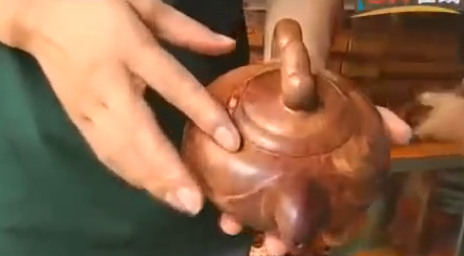I have written stories on crazy stones. Here is another story about crazy wood. Actually, it is not the wood that has gone crazy, it is the people who like the wood so much that they have gone mad over it, as they don't mind paying tons of money for it. There are people who paid millions of dollars for a few old beams dismantled from old houses in villages. There are also people who gamble on the quality of the wood, the way they gamble on jade boulder. This happened in a nation where money is not a problem.
The wood that has become crazy (to some people) is actually a wood commonly used to make furniture in the Ming and Qing dynasties. This is known as the
Huang Huali, a popular material for the furniture made in the Ming dynasty some 600 years ago. As the price of Ming and Qing antique furniture escalated over a few hundred times in the last decades, people begin to take note of this wood. It was long considered that this wood,
Huang Huali, has already depleted due to massive tree cutting during the Ming and Qing dynasties by the Imperial court for building palaces and furniture.
In the 90s, it was reported that the trees that produced the wood were sighted in Hainan, a small island in the south of the mainland. Ever since the report was published, people began to hunt for this wood there causing a flood of dealings in the wood. Many villagers became rich overnight and businessmen reaped huge profits form the dealings. Eventually the price of this wood reaches 20000 RMB per kg.
A young man was reported to have paid 30000 RMB for 2 small branches of this wood before knowing if the wood was of good quality. He later had the wood cut and realised that the purchase was worth it as he noticed good quality wood that could be made into valuable items that could be sold for a large sum of money. This is considerd by the locals as
wood gambling.
 |
| The story on Huang Huali |
Huang Huali wood is a highly sough after wood due to its characteristic wood pattern and attractive appearance. The texture is smooth, dense and very stable. A light fragrance will emit from the wood.
 |
| A branch of Huang Huali being cut |
 |
| Good wood seen after the cut |
Good quality
Huang Huali appears in the centre and is surrounded by a layer of white wood. Just imagine, large pieces of wood is required to make furniture. The trees have to be at least 400 years old before the trunks reach the size required for large furniture like beds and table. Hence
Huang Huali furniture is very costly.
 |
| Huang Huali furniture |
 |
| Huang Huali items |
 |
| A Huang Huali teapot |
 |
| Furniture made from Huang Huali |
 |
| Scientific name of Huang Huali |
 |
| A brush container made of Huang Huali, 180000 RMB |
 |
| Beams and columns sold for millions |
There was even one businessman who went to Hainan in the early 90s to look for this wood. He was able to amass 400 kg of Huang Huali products (mainly farming equipment) from villagers. After he had loaded his finds in a container and was about to leave the island, he saw some beams in a nearby house and immediately went to examine them. When he found out that the beams were made from
Huang Huali, he had them removed and paid the owner handsomely. After that he went from houses to houses to search for columns and beams. In this way, he was able to collect a large quantity of raw material for his furniture shop in Beijing. The most expensive price he ever paid for this wood was when he paid 1.38 million RMB for 6 beams removed from a villager's house. You may think he was mad to have paid so much for this wood. But he used these beams and columns and turned them into exquisite fine antique furniture in his factory. He ever sold a set of newly made
Huang Huali furniture for more than ten millions RMB during an exhibition. He had so much confidence in the wood that he even advertised in the press that his company would exchange gold with blocks of wood. Anybody could bring the wood to his company and be assessed. If it was what he wanted, he would weigh the wood and paid the owner in real gold. This was what they called the
Gold for Wood campaign.
 |
| Gold for wood campaign |
One villager commented that when the wood was very cheap in the early days (less than a dollar per kg), he even burned the wood during winter to get warm. He said unkowingly he burned away millions of dollars.
Today, villagers are encouraged to plant the trees so that future generations are ensure of a continuous supply for the wood. At first, they grow the trees on the mountain far away from where they live. After a few years, and before the trees can grow into full size, the trees are cut illegally but outsiders. This prompted the villagers to plant the trees near where they live and in-front of their houses. The trees are protected with thorns and alarms to prevent them from being stolen. They believe that if every household plants the trees, their children will have a better future.
 |
| Planting a tree infront of the house |




























